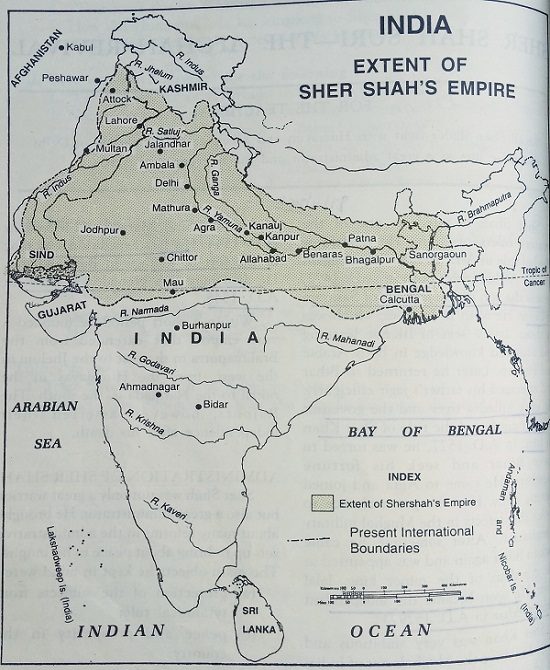Table of Contents
Sher Shah Suri:
Sher Shah is rated as one of the greatest rulers of India. He overthrew the Mughal rule in A.D. 1540 and once again revived the Aghan rule. Born in A.D. 1472, in the family of a jagirdar of Sasaram in Bihar and named as Farid. He went to Jaunpur, which was in those days a seat of Islamic learning and acquired knowledge in both Arabic and Persian.
Later he returned to Bihar and managed his father’s jagir efficiently. He once killed a tiger and the governor of Bihar (Bahar Khan Lodi) conferred the title of Sher Khan on him. In A.D. 1527, he was forced to leave Bihar and seek his fortune elsewhere. He came to Agra and joined Babur’s Army. Here he got a chance to notice the defects in the Mughal military organization. After some time he came back to Bihar again and was appointed as the guardian of the minor king, Jalal Khan. He soon became the independent ruler of Bihar in A.D. 1529.
Sher Khan was very ambitious and wanted to drive the Mughals out of India. He fought with Humayun and defeated him twice at Chausa (1539) and Kanauj (1540). His other conquests included that of Malwa, Multan and Sind, Marwar and Mewar in A.D. 1544. Sher Shah’s last campaign was against the fort of Kalinjar in Bundelkhand where he was victorious but died due to an accidental explosion of gun powder (1545). He built his own mausoleum in Sasaram in Bihar.
His empire consisted of the whole of North India except Assam, Nepal, Kashmir, and Gujarat.

Administration of Sher Shah Suri:
Sher Shah was not only a great warrior but also a great administrator. He brought about many reforms in the administrative set-up to bring about peace in his empire. The main objects he kept in mind were-
- Protection of the subjects from tyrannical rule.
- Peace and prosperity in the country.
- Repression of crime.
- Safety on the highways.
- Comfort of the soldiers and traders.
As an administrator, Sher Shah definitely deserves a very high place in the history of India.
Sher Shah Suri- Provincial Administration:
- Sher Shah’s empire was divided into forty-seven sarkars or provinces. Chief Shiqdar (law and order) and Chief Munsif (judge) were the two officers in charge of the administration in each sarkar.
- Each sarkar was divided into several Parganas. Shiqdar (military officer), Amin (land revenue), Fotedar (treasurer), Karkuns (accountants) were in charge of the administration of each pargana.
- There were also many administrative units called iqtas.
But Sher Shah was the head of the central administration. All the power was vested in the hands of the king himself. The king was assisted by four important ministers–
- Diwan –i- Wizarat – also called as Wazir – in charge of Revenue and Finance.
- Diwan-i-Ariz – in charge of Army.
- Diwan-i-Rasalat– Foreign Minister.
- Diwan-i-Insha– Minister for Communications.
Sher Shah Suri- Land Revenue Administration:
In the field of land revenue administration, Sher Shah made a greater contribution. Under him ‘Zabti System‘ started. The essential objectives behind the land revenue reforms under Sher Shah were to augment the income of the state as well as give protection to the peasants.
In his reforms, Sher Shah made the correction in the old system of Alauddin Khilji for the measurement of land. He made ‘Bigha‘ as a unit and introduced Gaj-i-Sikandri. After the measurement of land, the land was classified on the basis of productivity. So we find three categories of land- good, middle, and bad.
Like Alauddin Khilji he didn’t prefer to suppress Hindu nobility but rather he controlled them.
For the different crops, he prepared a rate-list that was called ‘Ray‘. It was certainly an improvement over the earlier system.
Apart from that Sher Shah introduced a new system ‘Patta‘ and ‘Qabuliyat‘. In the patta, the specific rights of peasants were specified and in Qabuliyat his liability towards the state was clearly defined. That’s why some scholars declared the system of Sher Shah as a ‘Ryotwari System‘. When we observe minutely we find that during the Medieval period no government was so much successful as to establish direct relations with peasants. But we cannot deny the fact that he tried to protect the interest of the peasantry to a greater extent. According to him, the peasants were the axis of production so in order to maintain the production they should be given proper security.
Sher shah fixed the rate of land revenue as one-third of the total production and it was paid in cash or crop. Apart from that, he imposed taxes like Zaribana and Muhasilana. Their rate was 2.5% and 5% of the total production respectively. The first was the salary given to the survey officers and the second one to the collector.
Furthermore, the peasants had to pay some extra tax in order to meet the exigencies during the time of famine. Its rate was 2.5 sair per bigha. So it is very difficult to conclude that the peasants had to part with how much amount with their production particularly for the fact that they had to give some share even to rural nobility.
Sher Shah Suri- Military Reforms:
Sher Shah Suri was a great warrior, so he paid special attention to the management of military affairs.
He borrowed many reforms from Alauddin Khilji. Like khilji he revived the system of maintaining the descriptive rolls of the soldiers (Chehra or Huliya) and the branding of the horses (Dagh).
He personally oversaw the recruitment of soldiers. Sher Shah paid fixed and regular salaries to his soldiers. He was a very strict disciplinarian and any soldier found guilty of indiscipline was severely dealt with. He maintained a huge army comprising not only Afghans but also soldiers of other nationalities including the Hindus.
To keep himself well-informed of all the happenings in his kingdom, Sher Shah organized a very efficient espionage system. With this, he was able to keep a check on the activities of the governors and officers of distant provinces also.
Sher Shah Suri- Dak Chowki System:
He started a sort of postal system known as the dak chowki system. According to this system, news or information was passed on from one corner of the empire to the other by horsemen who delivered the message to the next chowki. At every chowki, there were horsemen waiting to get information from the horsemen of the previous chowki.
Sher Shah Suri- Judicial Administration:
The judicial system of Sher Shah Suri was well-organized. It was inspired by the high ideals of justice. He gave fair and impartial justice to all, irrespective of one’s caste or religion, for he believed that “justice is the most excellent of all religious rites.”
No one could escape punishment if he deserved it because of his high or low birth. The criminal law was very severe. His main objective was not to reform the criminal but to set such an example for others that they would never dare to indulge in criminal activities. Peace and order were the responsibility of the village muqaddam. Besides this, the emperor’s spies also kept him well-informed of all that happened in the empire. Sher Shah took every step to ensure that the life and property of the people were safe and secure.
Sher Shah Suri- Introduction of New Currency:
During his rule, he introduced Dam– small copper coin, Mohur– the gold coin, and Rupiya– the silver coin.
Prior to his accession to the throne, the currency of the state was in a deplorable condition. The coins issued by the different Muslim rulers were still in circulation. These coins varied in a ratio that caused a lot of confusion. Sher Shah Suri abolished all the old coins and fixed the ratio and value of the new ones. This facilitated trade and commerce. Some of his coins, especially the silver rupiya were used by the Mughals who came after him and even by the British East India Company.
Sher Shah Suri- Works of Public Welfare:
Sher Shah Suri carried out many works for the welfare and convenience of his subjects. He built many sarais or roadside inns for the travelers and traders at an interval of every two kos. Here the travelers could spend the night and keep their belongings. These sarais were also used as dak chowkis.
In order to facilitate better communication and trade, he constructed many roads. The most important among them was the Grand Trunk Road or Sarak-i-Azom. This road ran from Sonargaon in Bengal (now near Dacca in Bangladesh) to Peshawar in the west. A second road ran from Agra to Burhanpur, a third from Agra to Jodhpur and Chittor, and a fourth from Lahore to Multan.
Trees were planted on both sides of the roads and arrangements were made for the provision of food and water for the travelers.
For the purpose of learning, he established many madrasas and gave rich donations. For the poor and the needy, he opened many kitchens where food was served free. Indeed, in this respect, he was more like a guardian to his subjects than any other Muslim king before Akbar the great.
Sher Shah Suri- Art and Architecture:
Although Sher Shah Suri ruled for a very short period of five years, he has left behind some remarkable specimens of architecture.
Sher Shah Suri founded the city of Rohtas near Delhi and built a fort there on the banks of the river Jhelum.
The Purana Qila or the Old Fort at Delhi is also believed to have been built by Sher Shah Suri.
Sher Shah Suri also built the elegant Masjid Qila-i-Kuhna and Sher Mandal within the Purana Qila. Sher Mandal was later converted into a library by Humayun.
Sher Shah Suri even built his own mausoleum at Sasaram in Bihar where he was buried after his death. This is regarded as a masterpiece of architecture.
Sher Shah Suri- Religious Policy:
Sher Shah Suri himself was a Sunni Muslim but was tolerant of other religions. He was fair in administering justice even to non-Muslims. He gave high posts to the Hindus. Raja Todar Mal, his revenue minister, and Brahmajit Gaur, his general, were both Hindus. The sarais that he built provided facilities to both Hindus and Muslims. However, he did not abolish Jeziah.
Successors of Sher Shah Suri and the Downfall of the Dynasty:
Sher Shah Suri ruled for a very brief period. He was a great ruler and had the qualities of a nation-builder. “If he had been spared”, feels Dr. Vincent A.Smith, “the mighty Mughals would not have appeared on the stage of Indian history.” But his untimely death and the weak and incompetent successors that followed him undid all that he had achieved during his five-year rule.
Sher Sha Suri died in A.D.1545 and was succeeded by his son, Jalal Khan who assumed the title of Islam Shah. He ruled up to A.D.1553 and tried to keep the empire intact by pursuing the policies of his father. After his death, Jalal Khan’s minor son, Firoz ascended the throne but he was murdered by his uncle, Mohammed Adil Shah who proclaimed himself as the new ruler.
Adil was a pleasure-seeker and left the reins of the government in the hands of his Hindu minister, Hemu. During this time there were revolts in various parts of the empire. Taking advantage of the situation, Humayun came back and captured the throne of Delhi in A.D. 1555. Thus came to an end the Suri empire and Mughal rule was established once again.
- Early Indian Nationalism
- The Home Rule League, 1916
- Rowlatt Act, 1919
- Jallianwala Bagh Massacre [April 13, 1919]
- The Khilafat Movement, 1919-1920
- The Non-Cooperation Movement (1920-22)
- Simon Commission, 1927
- Wardha scheme of education
- Cultural Developments in Medieval India– NIOS









Comments (No)